
- Tabletop games
- Board games
- Tile-based games
- Turn-based games.html
- Abstract strategy games
- card games
- Connection games
- Mancala games
- Paper-and-pencil games
- Word games



 The modern American board game Monopoly is licensed in 103 countries and printed in 37 languages.
The modern American board game Monopoly is licensed in 103 countries and printed in 37 languages.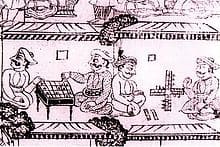 Men Playing Board Games, from The Sougandhika Parinaya Manuscript (1821)
Men Playing Board Games, from The Sougandhika Parinaya Manuscript (1821)A board game is a tabletop game that involves counters or pieces moved or placed on a pre-marked surface or "board", according to a set of rules. Games can be based on pure strategy, chance (e.g., rolling dice), or a mixture of the two, and usually have a goal that a player aims to achieve. Early board games represented a battle between two armies, and most modern board games are still based on defeating opposing players in terms of counters, winning position, or accrual of points (often expressed as in-game currency).
There are many varieties of board games. Their representation of real-life situations can range from having no inherent theme (e.g., checkers), to having a specific theme and narrative (e.g., Cluedo). Rules can range from the very simple (e.g., Tic-tac-toe), to those describing a game universe in great detail (e.g., Dungeons & Dragons) - although most of the latter are role-playing games where the board is secondary to the game, serving to help visualize the game scenario.
The time required to learn to play or master a game varies greatly from game to game. Learning time does not necessarily correlate with the number or complexity of rules; some games having profound strategies (e.g. chess or Go) possess relatively simple rulesets.
 Woman Playing Go, Astana Cemetery, Turpan (c. 744)
Woman Playing Go, Astana Cemetery, Turpan (c. 744)Board games have been played in most cultures and societies throughout history. A number of important historical sites, artifacts, and documents shed light on early board games such as:
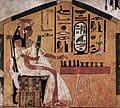
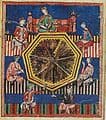



 The screene of fortune here behold, British fortune-telling game, c. 1650-1750
The screene of fortune here behold, British fortune-telling game, c. 1650-1750In seventeenth and eighteenth century colonial America, the agrarian life of the country left little time for game playing though draughts (checkers), bowling, and card games were not unknown. The Pilgrims and Puritans of New England frowned on game playing and viewed dice as instruments of the devil. When the Governor William Bradford discovered a group of non-Puritans playing stool-ball, pitching the bar, and pursuing other sports in the streets on Christmas Day, 1622, he confiscated their implements, reprimanded them, and told them their devotion for the day should be confined to their homes.
In Thoughts on Lotteries (1826) Thomas Jefferson wrote:
Almost all these pursuits of chance [i.e., of human industry] produce something useful to society. But there are some which produce nothing, and endanger the well-being of the individuals engaged in them or of others depending on them. Such are games with cards, dice, billiards, etc. And although the pursuit of them is a matter of natural right, yet society, perceiving the irresistible bent of some of its members to pursue them, and the ruin produced by them to the families depending on these individuals, consider it as a case of insanity, quoad hoc, step in to protect the family and the party himself, as in other cases of insanity, infancy, imbecility, etc., and suppress the pursuit altogether, and the natural right of following it. There are some other games of chance, useful on certain occasions, and injurious only when carried beyond their useful bounds. Such are insurances, lotteries, raffles, etc. These they do not suppress, but take their regulation under their own discretion.
The board game Traveller's Tour Through the United States and its sister game Traveller’s Tour Through Europe were published by New York City bookseller F. & R. Lockwood in 1822 and today claims the distinction of being the first board game published in the United States.
As the United States shifted from agrarian to urban living in the nineteenth century, greater leisure time and a rise in income became available to the middle class. The American home, once the center of economic production, became the locus of entertainment, enlightenment, and education under the supervision of mothers. Children were encouraged to play board games that developed literacy skills and provided moral instruction.
The earliest board games published in the United States were based upon Christian morality. The Mansion of Happiness (1843), for example, sent players along a path of virtues and vices that led to the Mansion of Happiness (Heaven). The Game of Pope or Pagan, or The Siege of the Stronghold of Satan by the Christian Army (1844) pitted an image on its board of a Hindu woman committing suttee against missionaries landing on a foreign shore. The missionaries are cast in white as "the symbol of innocence, temperance, and hope" while the pope and pagan are cast in black, the color of "gloom of error, and...grief at the daily loss of empire".
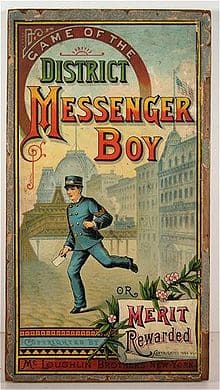 Game of the District Messenger Boy (1886) was one of the first board games based on materialism and capitalism published in the United States.
Game of the District Messenger Boy (1886) was one of the first board games based on materialism and capitalism published in the United States.Commercially produced board games in the mid-nineteenth century were monochrome prints laboriously hand-colored by teams of low paid young factory women. Advances in paper making and printmaking during the period enabled the commercial production of relatively inexpensive board games. The most significant advance was the development of chromolithography, a technological achievement that made bold, richly colored images available at affordable prices. Games cost as little as US$.25 for a small boxed card game to $3.00 for more elaborate games.
American Protestants believed a virtuous life led to success, but the belief was challenged mid-century when Americans embraced materialism and capitalism. The accumulation of material goods was viewed as a divine blessing. In 1860, The Checkered Game of Life rewarded players for mundane activities such as attending college, marrying, and getting rich. Daily life rather than eternal life became the focus of board games. The game was the first to focus on secular virtues rather than religious virtues, and sold 40,000 copies its first year.
Game of the District Messenger Boy, or Merit Rewarded is a board game published in 1886 by the New York City firm of McLoughlin Brothers. The game is a typical roll-and-move track board game. Players move their tokens along the track at the spin of the arrow toward the goal at track's end. Some spaces on the track will advance the player while others will send him back.
In the affluent 1880s, Americans witnessed the publication of Algeresque rags to riches games that permitted players to emulate the capitalist heroes of the age. One of the first such games, The Game of the District Messenger Boy, encouraged the idea that the lowliest messenger boy could ascend the corporate ladder to its topmost rung. Such games insinuated that the accumulation of wealth brought increased social status. Competitive capitalistic games culminated in 1935 with Monopoly, the most commercially successful board game in United States history.
McLoughlin Brothers published similar games based on the telegraph boy theme including Game of the Telegraph Boy, or Merit Rewarded (1888). Greg Downey notes in his essay, "Information Networks and Urban Spaces: The Case of the Telegraph Messenger Boy" that families who could afford the deluxe version of the game in its chromolithographed, wood-sided box would not "have sent their sons out for such a rough apprenticeship in the working world."
Margaret Hofer described the period of 1880s-1920s as the Gold Age of board gaming in America.
Around the year 2000 the board gaming industry began significant growth with companies such as Fantasy Flight Games, Z-Man Games, and Indie Boards and Cards churning out new games to be sold to a growing worldwide audience.
Many board games involve both luck and strategy. But an important feature of them is the amount of randomness/luck involved, as opposed to skill. Some games, such as chess, depend almost entirely on player skill. But many children's games are decided purely by luck: for example, Candy Land and Snakes and Ladders require no decisions by the players. A player may be hampered by a few poor rolls of the dice in backgammon, Monopoly, Risk, or cribbage, but over many games a skilled player will win more often. While some purists consider luck to be an undesirable component of a game, others counter that elements of luck can make for far more diverse and multi-faceted strategies, as concepts such as expected value and risk management must be considered.
A second aspect is the game information available to players. Some games (chess being a classic example) are perfect information games: each player has complete information on the state of the game. In other games, such as Tigris and Euphrates or Stratego, some information is hidden from players. This makes finding the best move more difficult, and may involve estimating probabilities by the opponents.
Another important aspect of some games is diplomacy, that is, players making deals with one another. Two-player games usually do not involve diplomacy (cooperative games being the exception). Thus, negotiation generally features only in games with three or more players. An important facet of The Settlers of Catan, for example, is convincing players to trade with you rather than with opponents. In Risk, two or more players may team up against others. Easy diplomacy involves convincing other players that someone else is winning and should therefore be teamed up against. Advanced diplomacy (e.g. in the aptly named game Diplomacy) consists of making elaborate plans together, with the possibility of betrayal.
Luck may be introduced into a game by a number of methods. The most common method is the use of dice, generally six-sided. These can decide everything from how many steps a player moves their token, as in Monopoly, to how their forces fare in battle, as in Risk, or which resources a player gains, as in The Settlers of Catan. Other games such as Sorry! use a deck of special cards that, when shuffled, create randomness. Scrabble does something similar with randomly picked letters. Other games use spinners, timers of random length, or other sources of randomness. Trivia games have a great deal of randomness based on the questions a player must answer. German-style board games are notable for often having less luck element than many North American board games.
Many board games are now available as video games, which can include the computer itself as one of several players, or as a sole opponent. Many board games can now be played online against a computer and/or other players. Some websites allow play in real time and immediately show the opponents' moves, while others use email to notify the players after each move. The internet and cheaper home printing has also influenced board games via print-and-play games that may be purchased and printed. Some games use external media such as audio cassettes or DVDs in accompaniment to the game.
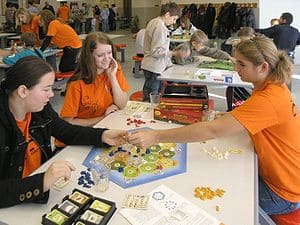 The modern German board game The Settlers of Catan is printed in 30 languages and sold 15 million by 2009.
The modern German board game The Settlers of Catan is printed in 30 languages and sold 15 million by 2009.While the board gaming market is estimated to be smaller than that for video games, it has also experienced significant growth from the late 1990s. A 2012 article in The Guardian described board games as "making a come back". Another from 2014 gave an estimate that put the growth of board game market at "between 25% and 40% annually" since 2010, and described the current time as the "golden era for board games". The rise in board game popularity has been attributed to quality improvement (more elegant mechanics and graphics) as well as increased availability thanks to sales through the Internet.
A 1991 estimate for the global board game market was over $1.2 billion. A 2001 estimate for the United States "board games and puzzle" market gave the value of under $400 million, and for United Kingdom, of about £50 million A 2009 estimate for the Korean market was put at 800 million won, and another estimate for the American board game market for the same year was at about $800 million. 2011 estimate for Chinese board game market was at over 10 billion yuan. (Some estimates may split board games from collectible card, miniature and role-playing games; for example another 2014 estimate distinguishing board games from other types of hobby games gave the estimate for US and Canada market at only $75 million, with the total size of what it defined as the hobby game market at over $700 million, with a 2015 estimate suggesting a value of almost $900 million) A 2013 estimate put the size of the German toy market at 2.7 billions euro (out of which, board games and puzzle market is worth about 375 million euro), and Polish markets, at 2 billions and 280 millions złoties, respectively. Per capita, in 2009 Germany was considered to be the best market, with the highest number of games sold per individual.
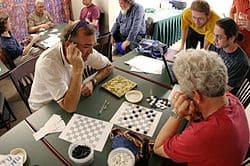 Board games serve diverse interests. Above: Konane, for studious competition. Right: Konane for lighthearted fun.
Board games serve diverse interests. Above: Konane, for studious competition. Right: Konane for lighthearted fun.

A dedicated field of research into gaming exists, known as game studies or ludology.
While there has been a fair amount of scientific research on the psychology of older board games (e.g., chess, Go, mancala), less has been done on contemporary board games such as Monopoly, Scrabble, and Risk. Much research has been carried out on chess, in part because many tournament players are publicly ranked in national and international lists, which makes it possible to compare their levels of expertise. The works of Adriaan de Groot, William Chase, Herbert A. Simon, and Fernand Gobet have established that knowledge, more than the ability to anticipate moves, plays an essential role in chess-playing.
Linearly arranged board games have been shown to improve children's spatial numerical understanding. This is because the game is similar to a number line in that they promote a linear understanding of numbers rather than the innate logarithmic one.
Research studies show that board games such as Chutes and Ladders result in children showing significant improvements in aspects of basic number skills such as counting, recognizing numbers, numerical estimation and number comprehension. They also practice fine motor skills each time they grasp a game piece. Playing board games has also been tied to improving children's executive skills.
Additionally, board games can be therapeutic. Bruce Halpenny, a games inventor said when interviewed about his game:
With crime you deal with every basic human emotion and also have enough elements to combine action with melodrama. The player’s imagination is fired as they plan to rob the train. Because of the gamble they take in the early stage of the game there is a build up of tension, which is immediately released once the train is robbed. Release of tension is therapeutic and useful in our society, because most jobs are boring and repetitive.
Playing games have been suggested as a viable addition to traditional educational curriculum.
A common division of board games is into European- (also known as German-) and American-style games.
There are a number of different categories that board games can be classified into, although considerable overlap exists, and a game may belong in several categories. Listing of board games by type over feature over thirty different categories. The following is a list of some of the most common:
Although many board games have a jargon all their own, there is a generalized terminology to describe concepts applicable to basic game mechanics and attributes common to nearly all board games.